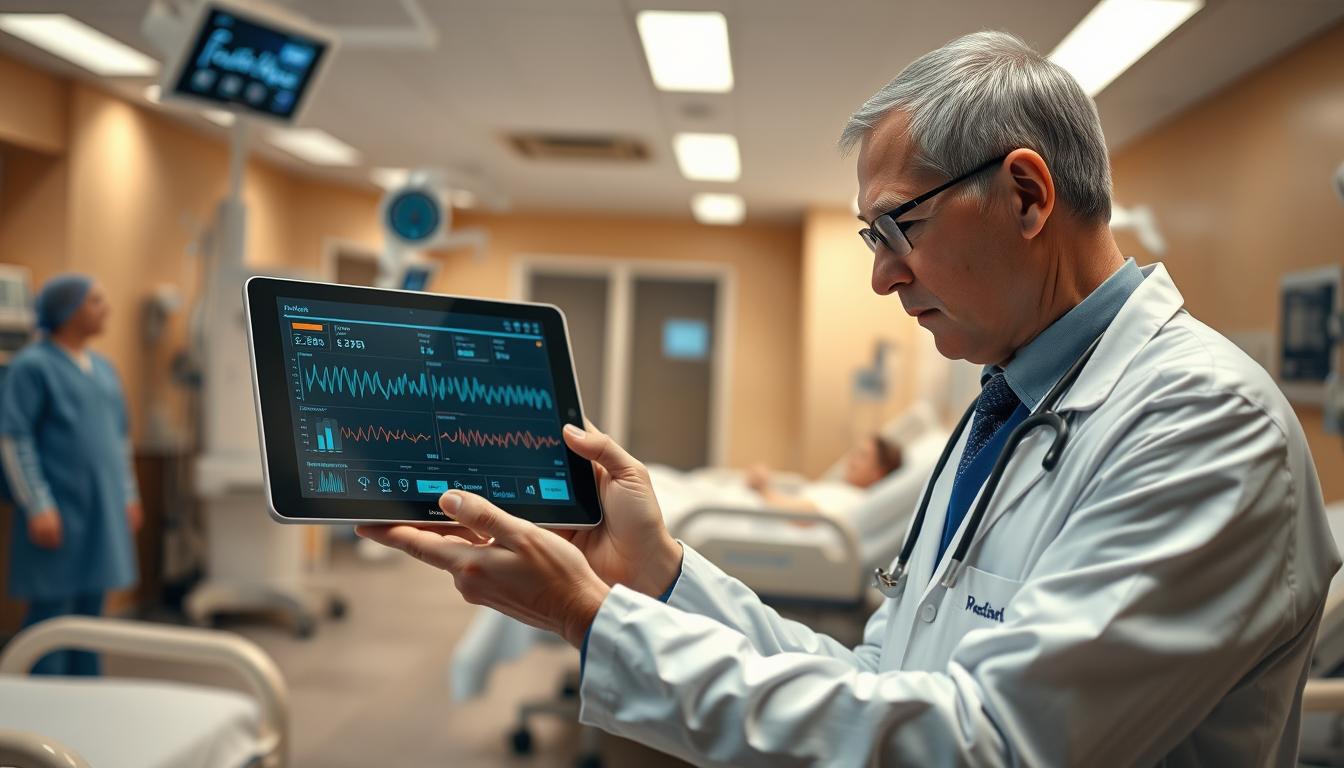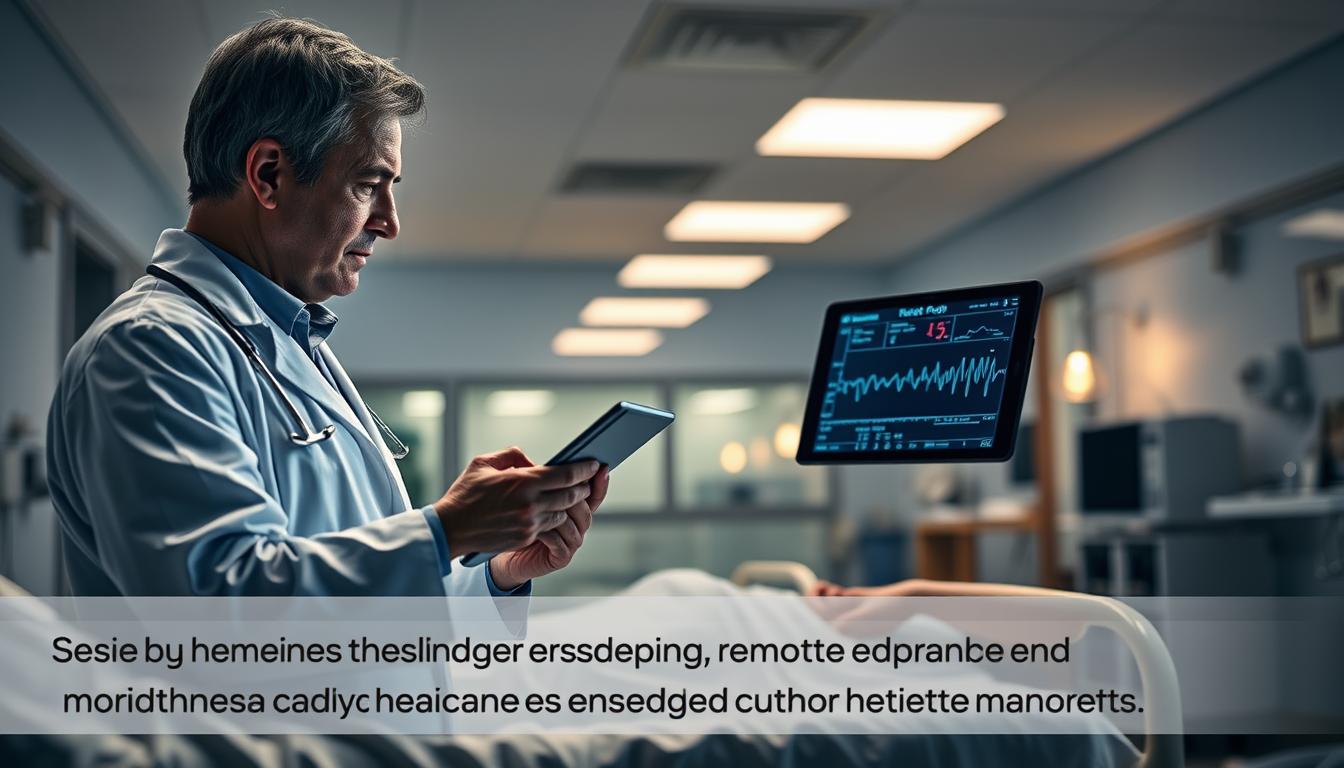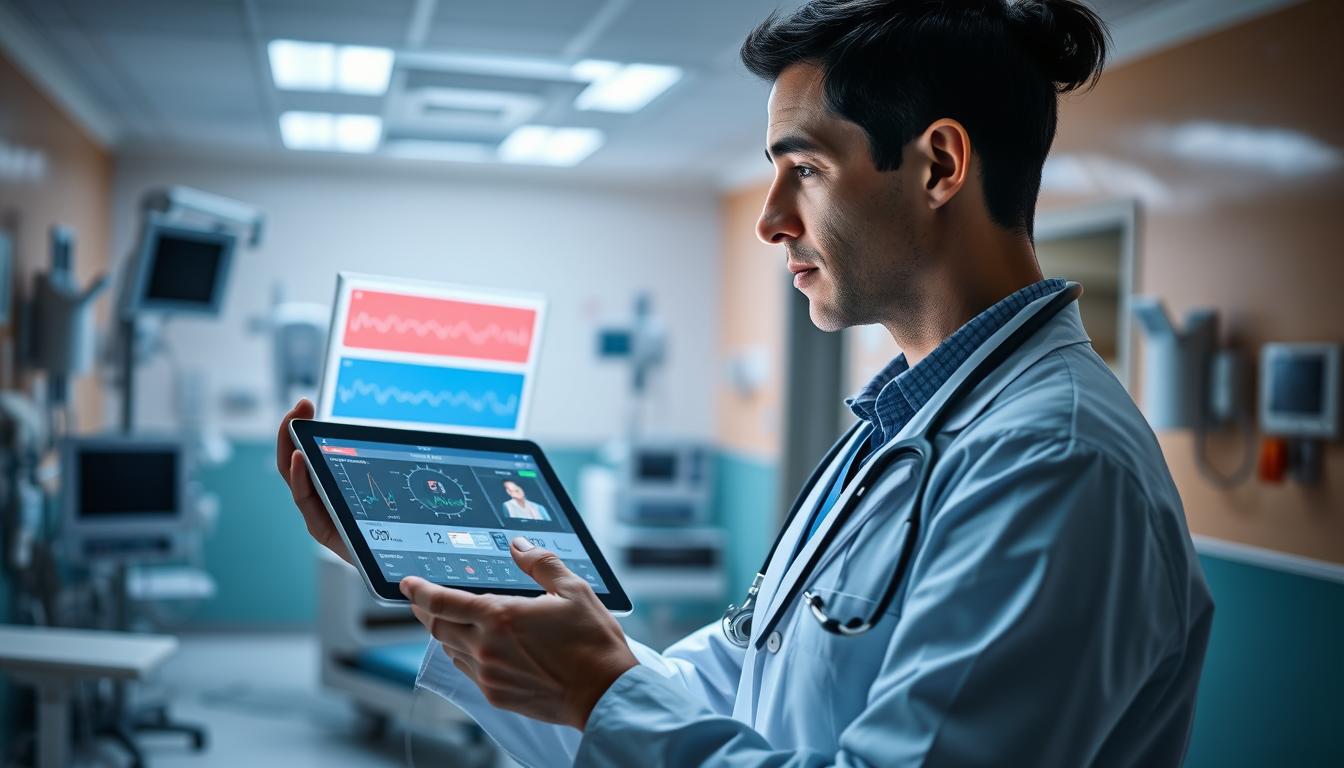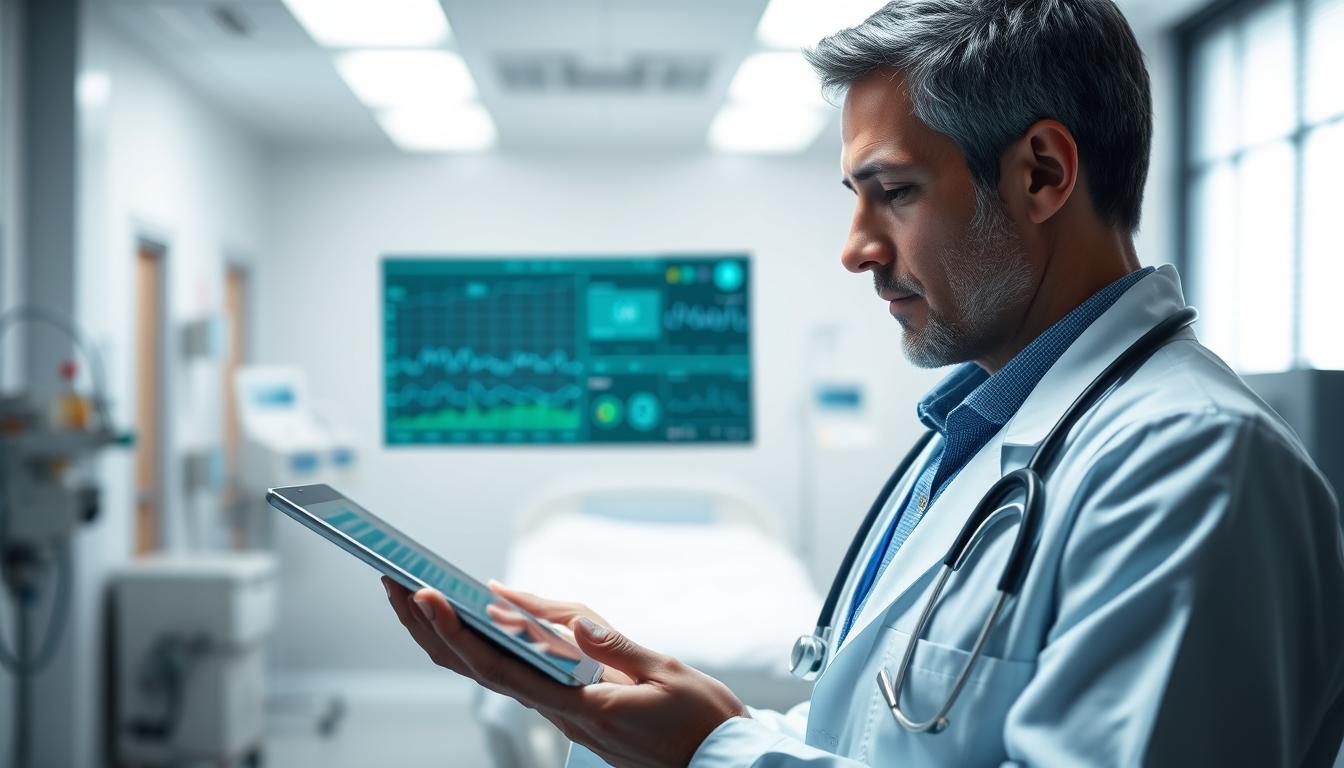When a night nurse spent 20 minutes searching for an oxygen unit, a shift of care slowed and costs rose. That small delay illustrated a bigger issue: fragmented workflows and missing devices cost hospitals time and money.
Modern connectivity changes the scene. By linking wearables, clinical gear, and staff tools, iot healthcare solutions deliver continuous vital signs and real-time data to clinicians. This reduces errors, speeds decisions, and improves patient care.

Reliable wireless range, higher transmit power, and strong receiver sensitivity keep signals steady across thick walls and metal infrastructure. Security matters too; hardware-level certifications like PSA Level 3 Secure Vault protect information in regulated markets.
For U.S. leaders evaluating smart hospital IoT systems, expect seamless EHR integration, secure device-to-cloud workflows, and clear ROI from fewer readmissions and faster clinician response. Iottive brings BLE app development, device integration, and custom platforms to guide pilots from proof to scale.
Key Takeaways
- Connected devices deliver continuous vital signs and timely data for better decisions.
- Robust RF design and high TX power improve reliability in dense hospital environments.
- Security at the SoC level is essential for compliance and trust.
- Integrated platforms reduce clinician time lost to manual tasks and device searches.
- Choose partners that offer BLE apps, cloud integration, and end-to-end support like Iottive
Why IoT Patient Monitoring Matters Now in the United States
Across American hospitals, limited resources and heavier caseloads create a fast-growing need for real-time connectivity. Rising volumes and clinician burnout mean leaders must reclaim staff time and improve workflow efficiency without lowering care quality.
“An average $500,000 is lost for every 20 minutes removed from a nurse’s shift.”
Quantify the urgency: connected solutions restore minutes and hours to staff schedules by automating routine tasks and reducing time spent locating equipment. This directly protects clinical capacity and facility budgets.
From wearables to clinical-grade devices: the market moved beyond fitness trackers to systems that track heart rate, ECGs, and glucose trends. Continuous data enables timely interventions and lowers readmission risk.
Operationally, networks reveal staff movements and patient journeys so leaders can cut idle time and streamline processes across facilities. Providers gain better situational awareness and can prioritize care for higher-need patients.
Iottive builds Bluetooth-connected solutions and custom platforms that help U.S. healthcare providers modernize patient care and operations, from pilot projects to full-scale deployment.

Core Benefits of IoT Patient Monitoring and Smart Hospital IoT Systems
When devices share reliable signals, teams spot deterioration before it becomes an emergency. That shift from intermittent checks to continuous insight improves outcomes and reduces avoidable readmissions.

Proactive care
Real-time vital signs — heart rate, blood pressure, oxygen saturation, and glucose levels — feed alerts and analytics. Early detection of abnormal signs prompts timely interventions and cuts readmission risk.
Operational gains
Automated tracking of equipment and asset locations saves staff time and lowers losses. Streamlined workflows free clinicians to spend more time on direct care, improving overall efficiency.
Data accuracy and accessibility
Proactive care
Real-time vital signs — heart rate, blood pressure, oxygen saturation, and glucose levels — feed alerts and analytics. Early detection of abnormal signs prompts timely interventions and cuts readmission risk.
Operational gains
Automated tracking of equipment and asset locations saves staff time and lowers losses. Streamlined workflows free clinicians to spend more time on direct care, improving overall efficiency.
Data accuracy and accessibility
Automated capture removes transcription errors. Clean data flows into EHRs so clinicians and providers access reliable information to guide decisions and counseling.
Patient experience
At-home and in-clinic tools make care more convenient and safer. Personalized trends let teams tailor treatment for chronic conditions like diabetes and hypertension.
Iottive’s end-to-end IoT/AIoT expertise ensures benefits are realized across device connectivity, cloud integration, and user experience.
High-Impact Use Cases Buyers Should Prioritize
Targeted deployments deliver measurable gains when buyers focus on high-impact clinical and operational use cases. Start with projects that reduce readmissions, cut asset loss, and speed response times.
Clean data flows into EHRs so clinicians and providers access reliable information to guide decisions and counseling.
Patient experience
At-home and in-clinic tools make care more convenient and safer. Personalized trends let teams tailor treatment for chronic conditions like diabetes and hypertension.
Iottive’s end-to-end IoT/AIoT expertise ensures benefits are realized across device connectivity, cloud integration, and user experience.
High-Impact Use Cases Buyers Should Prioritize
Targeted deployments deliver measurable gains when buyers focus on high-impact clinical and operational use cases. Start with projects that reduce readmissions, cut asset loss, and speed response times.
![]()
Remote monitoring for chronic conditions and post-acute care
Continuous streams of heart rate, glucose, and ECG data enable rapid interventions for diabetes, cardiac disease, and hypertension. Philips’ cardiac monitoring is a strong example for arrhythmia detection and clinician alerts that reduce preventable readmissions.
Asset and inventory tracking
Tagging pumps, ventilators, and specialty equipment cuts losses and prevents overbuying. Real-time tracking saves staff time locating tools and keeps facilities stocked for urgent needs.
Smart beds and connected rooms
Pressure and posture sensing reduce falls and pressure injuries. Mount Sinai’s deployments show how beds and room integrations improve safety and workflow for bedside teams.
Automated alerts and emergency response
Threshold and trend alarms speed escalation across inpatient and outpatient settings. Integrate fall detection and abnormal vital alerts to close the gap between an event and action.
IoT-assisted procedures and post-op analytics
Robotic and connected surgical tools increase precision and capture intraoperative data for recovery pathways. Cleveland Clinic’s connected post-surgery kits spot early complications and support timely intervention.
- Quick wins: chronic care pilots and asset tags that show ROI fast.
- Scale goals: workflow integration so tracking and alerts flow into familiar clinical tools.
- Operational readiness: verify maintenance, cybersecurity updates, and clinical governance before rollout.
Architecture 101: From Connected Medical Devices to Cloud and Mobile
Design begins with a clear data path. Start at the device layer and plan through radios, gateways, cloud ingestion, and clinician apps. This keeps equipment and wearables feeding usable data to care teams and operations staff.

Device layer
Sensors, wearables, and clinical medical devices collect vital streams in real time across wards and at home. Choose medical devices with secure elements and long battery life to lower maintenance and support continuous tracking.
Connectivity choices
Use BLE for low-power device links and Wi‑Fi for high throughput. Gateways bridge protocols and translate data when radios face interference from metal and electromechanical noise.
RF resilience and power design
Plan for harsh RF conditions with radios offering 20 dBm TX power and high receiver sensitivity. Favor ultra‑low power SoCs like BG27 with DCDC and Coulomb Counter features to extend field lifecycles.
Cloud, mobile integration, and interoperability
Implement standardized data pipelines: ingest, normalize, store, and stream to analytics engines. Build clinician and patient apps that simplify setup, alerts, and trend review.
Interoperability matters: expose FHIR/HL7 APIs so EHR workflows include the same data clinicians already use. Define governance, SLAs, and ownership to keep operations reliable.
| Layer | Key components | Design focus | Outcome |
|---|---|---|---|
| Device | Sensors, wearables, medical devices | Security, battery life, certified chipsets | Continuous, accurate data |
| Connectivity | BLE, Wi‑Fi, gateways | RF resilience, coexistence, throughput | Reliable links across facilities |
| Cloud & Apps | Ingestion, storage, mobile clients | Normalization, APIs, analytics | Actionable insights for care and operations |
| Integration | FHIR/HL7, APIs, governance | Interoperability, SLAs, support | Seamless workflows in EHRs |
Iottive delivers BLE app development, cloud/mobile integration, and custom platforms to unify data and connect medical devices with enterprise systems. Built correctly, architecture turns continuous streams into useful analysis and timely alerts for hospitals and facilities.
Security, Privacy, and Compliance You Can’t Compromise
Protecting clinical data starts at silicon and extends to people and processes. The medical market is highly regulated and a frequent target for attacks on patient privacy and record data. Secure design reduces risk and preserves trust in care delivery.
Threat surface and device-to-cloud hardening
Connected devices, mobile apps, gateways, and cloud endpoints expand exposure. Enforce secure boot, firmware signing, encrypted storage, and TLS to protect data in transit and at rest.

HIPAA-aligned handling, access control, and auditability
Require strong authentication, role-based access, least-privilege permissions, and full audit trails for all information access. Design retention and breach workflows to meet HIPAA obligations and patient rights.
Selecting components with proven, certified security
Prefer chipsets with PSA Level 3 Secure Vault and documented secure development lifecycles. Implement OTA updates, SBOM tracking, and vulnerability management to keep monitoring safety over time.
- Data minimization: collect only essential health fields; use tokenization or anonymization.
- Incident readiness: maintain runbooks for detection, containment, and recovery.
- Vendor diligence: require attestations, pen-test reports, and continuous compliance evidence.
Iottive delivers secure, compliant deployments built with BLE, cloud, and mobile designed for healthcare privacy and auditability. Pair technical controls with staff training to keep patients and information safe.
Evaluating Vendors and Platforms: A Practical Checklist
Selecting a partner requires clear proof of uptime, security, and long-term support. Use this checklist to compare offerings on clinical accuracy, lifecycle support, and operational fit.
Clinical-grade accuracy, reliability, and uptime SLAs
Demand validated accuracy for medical devices and clear labeling for intended use. Require uptime SLAs that protect patient safety and care continuity.
Battery life, maintenance, and lifecycle support
Verify battery performance under real-world duty cycles and ask about field-replaceable options.
Look for ultra-low power designs and tools like Coulomb Counters that extend device life over a decade.
Scalability, interoperability, and total cost of ownership
Confirm FHIR/HL7 integrations, open APIs, and proven EHR connectors to reduce custom work.
Model TCO across hardware, cloud, software licenses, maintenance, and inventory impact.
- Connectivity resilience: test radios in challenging RF and coexistence scenarios.
- Security posture: require chipset certifications, secure OTA updates, and rapid vulnerability response.
- Analytics readiness: confirm data quality, labeling, and pipelines so staff can act on insights and tracking workflows.
- Support model & tooling: demand responsive services, training, and easy tools for IT and biomed teams.
Iottive offers end-to-end IoT/AIoT services, BLE apps, and custom platforms with lifecycle support to meet clinical and operational needs. Validate references, run pilot tests, and require a clear roadmap before scaling.
Building the Business Case: ROI, Costs, and Time-to-Value
Leaders need clear financials before committing to new care technologies. Start by mapping baseline costs and the specific pain points that drive waste, such as time lost searching for equipment or avoidable readmissions.
Where savings accrue:
- Fewer admissions and shorter stays: early alerts and predictive analysis reduce complications and cut direct costs.
- Return staff time: streamline documentation and equipment location so clinicians spend more time on patient care and less on manual tasks.
- Better asset utilization: track high-value devices to avoid losses and unnecessary purchases, improving readiness for procedures.
- Higher quality data: cloud analytics and clean information help target interventions and lower downstream resource use.
Design pilots with a defined cohort, baseline metrics, and clear success criteria tied to admissions, response time, and staff efficiency. Capture both clinical and operational KPIs: time saved, alert-to-action intervals, readmission rates, and patient-reported outcomes.
Cost modeling and risk planning: include devices, connectivity, cloud, integration, training, and support to show a transparent TCO and time-to-value. Factor in RF site surveys, security assessments, and change management to protect care delivery during rollout.
Funding strategy: phase deployments to deliver early wins and recycle savings into scale. Iottive helps quantify ROI through pilots that integrate BLE devices, cloud analytics, and mobile apps, then scale to enterprise-wide deployments.
Partnering for Success: How Iottive Delivers End-to-End IoT/AIoT Healthcare Solutions
Effective deployments blend firmware, apps, and cloud services into a single, supported offering.
BLE app development and smart device integration for connected care
BLE expertise: design and build Bluetooth apps and firmware that pair quickly, stream data reliably, and minimize power draw for connected care.
Custom IoT platforms with cloud & mobile to unify patient and operations data
Custom platforms: deliver cloud and mobile solutions that unify operational and patient data, support alerts, dashboards, and analytics for care teams.
From prototype to production: secure, scalable, and compliant deployments
Security-first deployments use certified components, encrypted pipelines, and audit trails from prototype through production. Iottive architects for scale so devices and infrastructure onboard without performance loss.
Industries served and healthcare-specific expertise
- Interoperability with EHRs and clinical workflows to increase adoption.
- Cross-domain lessons from Automotive, Smart Home, and Industrial IoT hardened for healthcare.
- Lifecycle support: updates, monitoring, and enhancements that keep systems aligned with clinical needs.
Get in touch: www.iottive.com | sales@iottive.com
Conclusion
,When data flows cleanly from devices to apps, teams gain the confidence to act fast.
Connected devices and rich data turn reactive workflows into proactive patient care that improves outcomes and safety.
Hospitals and providers that align technology with clinical need see faster time-to-value and lasting benefits.
Prioritize security, interoperability, and pragmatic pilots. Protect health information with certified components, strong access controls, and auditable designs so providers trust the solution.
Scale thoughtfully: start with focused pilots, measure results, invest in training, then expand across facilities.
Choose partners who understand clinical constraints and lifecycle support. Iottive can help U.S. healthcare organizations plan, build, and scale secure IoT/AIoT solutions—from BLE apps and connected devices to cloud platforms.
Next step: visit www.iottive.com or email sales@iottive.com to begin your iot healthcare journey.
FAQ
What is remote patient monitoring and how does it improve care?
Remote patient monitoring uses connected medical devices and wearables to gather vital signs and health data outside clinical settings. This continuous feed enables early detection of deterioration, timely interventions, and fewer readmissions. Care teams gain better visibility into chronic conditions like heart failure and diabetes, while patients enjoy more convenient, personalized care.
Why is connected monitoring increasingly important for U.S. healthcare providers?
Rising demand, workforce shortages, and cost pressures push providers to adopt solutions that boost efficiency. Connected monitoring streamlines workflows, reduces time spent on manual checks, and helps hospitals manage resources and beds more effectively. It supports value-based care goals by improving outcomes and lowering avoidable utilization.
What types of devices are used in modern connected care programs?
Programs combine clinical-grade sensors, wearables, smart beds, and asset tags. Devices range from continuous glucose monitors and cardiac telemetry to pulse oximeters and infusion pumps. Integrating these devices with apps and gateways creates a reliable data pipeline for clinical decisions and operational analytics.
How do hospitals handle data integration with electronic health records?
Effective deployments use interoperability standards and APIs to push device data into EHRs and clinical workflows. Middleware or platforms translate device formats, normalize streams, and enforce governance. The result is fewer manual entries, more accurate records, and faster clinician access to actionable information.
What are the main operational benefits beyond clinical improvement?
Facilities see time savings, reduced equipment loss through asset tracking, and lower supply waste. Automated alerts and location services speed response times. These gains translate into lower operating costs, better staff productivity, and improved patient throughput.
How do providers choose connectivity for a medical environment?
Selection depends on range, reliability, and interference tolerance. Many deployments use BLE for low-power wearables, Wi‑Fi for high-bandwidth devices, and gateways to bridge networks in complex RF environments. Redundancy and network segmentation help maintain uptime and security.
What security and privacy measures must be in place?
Device-to-cloud encryption, strong access controls, and audit trails are essential. Systems should meet HIPAA requirements and incorporate device hardening, secure firmware updates, and certificate-based authentication. Choosing vendors with certified security practices reduces risk across the deployment.
Which use cases deliver the fastest return on investment?
High-impact pilots include remote care for chronic disease management, post-acute monitoring to prevent readmissions, asset tracking to reduce equipment purchases, and smart-room features that prevent falls and pressure injuries. These areas drive measurable savings and quick time-to-value.
What should buyers evaluate when selecting a vendor or platform?
Prioritize clinical-grade accuracy, uptime SLAs, and proven interoperability with EHRs. Assess battery life and maintenance needs, scalability, and total cost of ownership. Verify regulatory compliance and ask for references from similar facilities.
How do pilots scale to full production without disrupting operations?
Start with clear clinical goals, defined KPIs, and a phased roll-out. Keep integrations lightweight at first, validate workflows, and train staff. Use pilot data to refine alerts, workflows, and support plans before broad deployment to minimize disruption.
What role do analytics and AI play in connected care?
Analytics surface trends, predict deterioration, and prioritize alerts to reduce alarm fatigue. Machine learning models can flag early signs of sepsis or respiratory decline and support clinical decision-making. Robust analytics turn raw telemetry into actionable insight for providers.
How can facilities ensure reliable device maintenance and lifecycle support?
Define maintenance schedules, remote diagnostics, and replacement policies up front. Work with vendors that offer lifecycle management, extended warranties, and field service. Asset tracking also helps monitor device status and streamlines preventive maintenance.
Are there common pitfalls to avoid when deploying connected solutions?
Avoid overcomplicating workflows, neglecting staff training, and skipping interoperability testing. Underestimating network capacity or security needs can cause failures. Clear governance, pilot validation, and vendor accountability reduce these risks.
How do connected monitoring programs affect patient experience?
They increase convenience, reduce clinic visits, and enable more personalized care plans. Patients report higher satisfaction when devices are easy to use and data drives clear, timely communication from care teams. Proper onboarding and support sustain engagement.
What compliance standards should organizations confirm before purchase?
Confirm HIPAA alignment, relevant FDA guidance for medical devices, and cybersecurity frameworks such as NIST. Look for vendors with documented certifications and third-party security assessments to ensure regulatory readiness.
How do asset-tracking systems reduce costs in healthcare facilities?
Real-time location services cut search time for critical equipment, lower replacement purchases, and improve utilization. Tracking reduces theft and loss, optimizes inventory levels, and enables faster response for clinical needs.
Can connected systems support both inpatient and outpatient workflows?
Yes. Platforms designed for interoperability and secure mobile access can span acute, ambulatory, and home settings. Unified data views let clinicians follow patients across care transitions and coordinate interventions more effectively.
What metrics should organizations track to measure success?
Track readmission rates, length of stay, staff time savings, equipment utilization, alarm response times, and patient satisfaction. Financial KPIs like cost per avoided admission and total cost of ownership help quantify ROI.